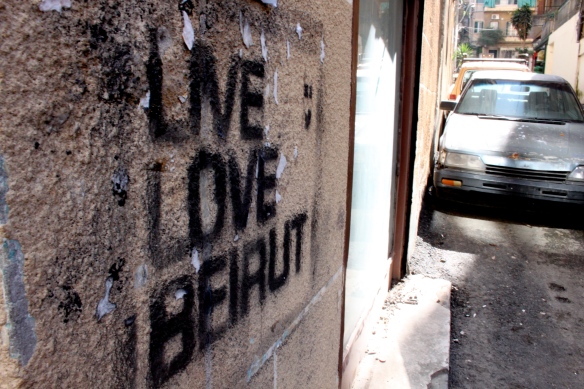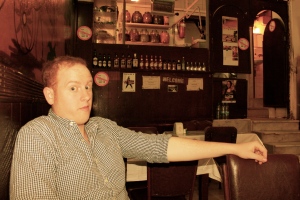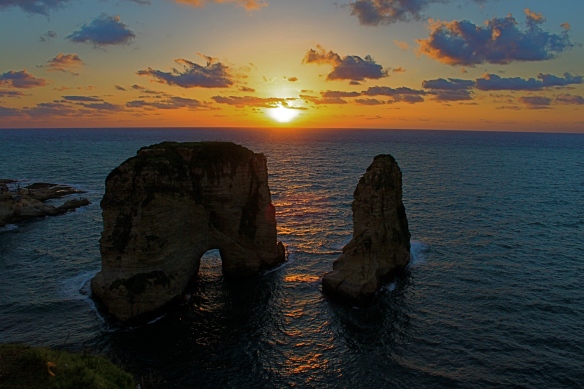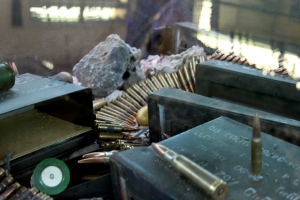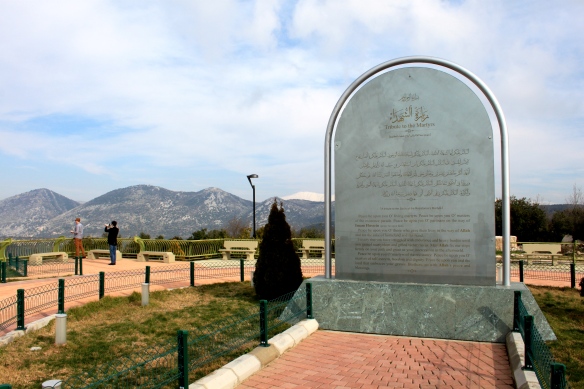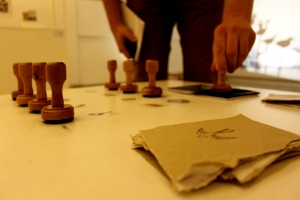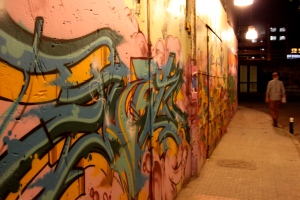…with a city of contradictions.
Beirut is: beautiful, chaotic, ugly, relaxed, noisy, chilled, destroyed, under construction, full, thriving, soulful, bombed out, loving and loved, misunderstood.
Beirut is real.
Beirut smells of petrol, and coffee, and food, and alcohol, and cigarettes, and people.
Beirut is alive.
One can only do so many visa runs to Dubai while work visas are lost, and sent to the wrong places, and set on fire or whatever has happened to my paperwork.
After a while, hopping back and forth between cities in the Gulf begins to get to you. The Gulf is easy, clean, clinical, and largely soul-less.
In Doha and Dubai the people make the cities, in Beirut the city makes the people.
The early morning flight out of Doha meant that I was able to stretch out across a row of three seats and sleep my way into the chaotic wonderfulness of Lebanon.
My first impression of Beirut was that it was an ugly city, but it only took a few hours for me to realise how wrong I was to think that the bombed out buildings, the windowless shells,the faded facades and French colonnades, were anything but majestic.
Every bullet mark, every pile of crumbling masonry that used to be a building, adds to the soul of the city.
After the pristine building and lifeless streets of West Bay, the thriving, shouting city filled me. As did the excessive amount of food I ate during my 4.5 days there.
Seriously, I think I ate twice my body weight in meat and carbs, hummus and moutabal, bacon and more bacon.
We spent the first afternoon exploring Hamra, one of the main neighbourhoods, and generally getting used to the city and its sounds. A visit to the American University of Beirut campus reawakened my thoughts about going back to university as we explored the lush green grounds. Then I saw some students, all of whom looked about 12, and felt indescribably old.
The main findings on the first day were: realising that there was no such thing as a metered taxi, and that everyone was happy to take Lebanese pounds, American dollars, or a combination of the two. Often change came back in a mix of currencies and we ended up doing unnecessarily complicated maths to work out if what we had in our hands was correct.
Our first evening out was in Gemmazeh, the big bar area where small bars run either side of the street and slowly fill up with a mix of students, tourists, and locals until each one is a mess of noise and laughter.
Being able to drink outside, in the street, for less than 60QR a drink resulted in us both going slightly mad and the evening became a blur of rum, whiskey, and at some point free shots from various happy barmen.
The bars have also adopted either a no smoking inside policy or had clearly defined smoking areas, meaning that when we eventually rolled home, although we probably smelt like a brewery, we didn’t smell like a smoke house as well.
The next morning we headed out to guidebook-recommended ‘Le Chef’ on the same
street that had caused our need for a lot of food and coffee in the first place. It ended up being a simple and inexpensive breakfast of Middle Eastern staples; hummus with meat, moutabal, and fatteh. With coffee and juice. This marked the start of our adventure through Lebanese meal times. The food was good and there was a lot of it and we ploughed through while I attempted to get into the groove of speaking French for the first time in years.
Fully restored and ready to face the day we headed to the National Museum and encountered a lovely but mildly insane taxi driver along the way. Had I been in Beirut alone, I would have found the fact that taxi drivers often seemed to have someone else in the front of the car with them fairly intimidating. There are recognised firms which didn’t do this, so if you’re heading by yourself ask your hotel who to use.
The National Museum wasn’t massive, but it is very well curated, with a range of artifacts that nicely embodies the wide-ranging history of Lebanon through the ages.
A quick coffee, a huge plate of shawarma, salad, and fries, an iced tea and a food-coma/nap depending on your point of view and it was off out to the Corniche to see the Pigeon Rocks, the naturally-formed arches just off the coast.
A night out in Hamra was a lot more relaxing than our previous evening and after dinner (or in my case mint tea and Shisha) we took a stroll around the bars until we accidentally ran into an old friend of mine.
The rest of the evening was spent learning about Lebanon from the people who live there. My friend chatted freely about the fact that once they got their qualifications, the best educated Lebanese would leave, and only rarely return.
Most people, we were told, were struggling to find work, the economy was shit and Lebanon barely existed as a country, but when we asked about the influx of refugees that come to the country seeking safety from, first Armenia, and more recently Syria there were shrugs and smiles rather than resentment.
“This whole area is full of Syrians now, a lot stay by the borders but a lot of the richer people come here. We don’t mind, it makes the city better. There are more people to party with.”
More food, an early night (12.30) and up the next day to head to Mleeta, ‘Where the land speaks to the heavens,’ acquiring a friend of Dane’s from home along the way.
About a 90 minute ride from Beirut (coaches and cars depart from the Kuwaiti
embassy, or if you luck out and find a good driver like we did, go with him,) Mleeta is home to the Resistance Tourist Landmark, a museum slash installation art gallery that tells the story of Hezbollah.
The site was chosen because it was where the resistance fighters positioned themselves against the Israelis. The museum itself is well put together and, while obviously not impartial, it is not as in-your-face one-sided as you might expect. Instead a free guide, a 15 minute introductory film that phrases things in ways that would not fly in history books, and various well-written signs around the place allow the Hezbollah message to sink in without any
fist-shaking or banner waving (metaphorical or otherwise.)
I wasn’t really sure what to expect from this museum. You can see outposts that had previously been occupied by Israeli forces and you are bombarded with military imagery and political messages, but at the same time, they put across their message in a very sophisticated way, and the site itself is like an art installation nestled in mountains that have previously been ripped apart by shells and bullets.
Art played a strong role throughout our trip and after getting back to Beirut (having eaten excessively large chicken taouk on the road) we headed to the Beirut Art Centre to check out some of the modern art on display. The current exhibitions were largely video installations, some of which were interesting while others were close to being pretentious.
The upper level of the gallery had a display of birds depicted through various mediums and any fans of Portlandia will be happy to know that we were able to put a bird on it.
The main attraction, however, was the graffiti on the wall outside. Left over from a previous exhibition, the owners of the neighbouring building had asked the centre to use its walls for the displays and leave the work there afterwards.
Another big night out, this time the three of us were back in Gemmazeh and, at my behest, re-visiting a bar that had previously contained a very attractive man behind it. Alas, he was not there, but we still had another evening of excellent drinks in some excellent bars followed by a (probably) excellent burger and a brief argument in which Dane tried to convince me that 10am was too early to leave for Baalbek the next day.
I won, and it was with mild hangovers that the three of us hit the winding road the next morning. I fought sleep and was treated to some stunning views of Lebanon as we wound our way up through the mountains to the ancient site so I could geek out about classics and the boys could revert to being five-year-olds and climb all over the ruins.
After lunch, obviously.
The site includes various temples dedicated to various deities as well as some additional fortifications when it was used as a citadel during the crusader period.
The area was originally settled by the Phoenicians because of its access to water and its position on two major trade routes.
Also it’s super fun to get stuck on top of some of the rocks.
Having been to sites around Italy and Greece, this was one of the best, not least because you don’t have the sterilisation that comes with a fear of law suits so you are free to roam around the ruins as much as you like.
Back to Beirut, playing the alphabet game along the way, and a nap that turned into a two-hour sleep and we were back out in Hamra for dinner and to meet up with another friend of mine.
The next morning was a rush of packing, bacon, losing my passport at the airport, having a mild heart attack, coffee, and back on the plane (this time full of screaming children and not nearly as fun) and back to Doha in time for the rugby.
So that was Beirut (and some surrounding culture.) The choice between Byblos and Baalbek was a tough one and I definitely want to return to see more of the country and learn more about the people that party their way through war and refugees and elections.
Now I’m off to eat steamed vegetables and run until my waistline returns to normal.

